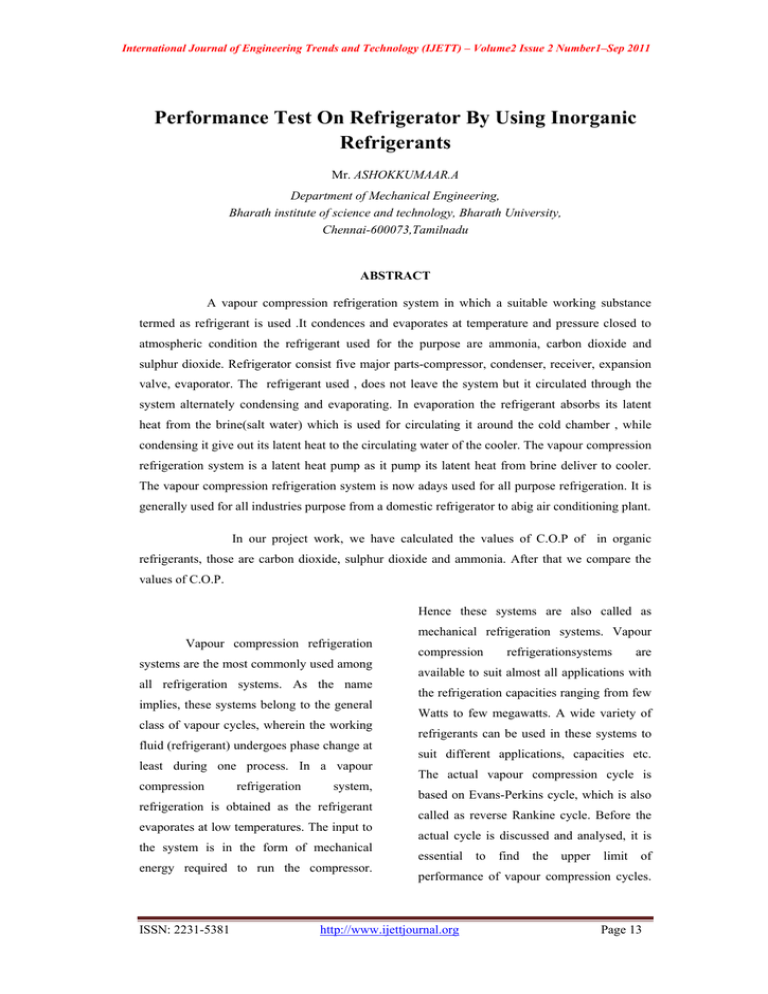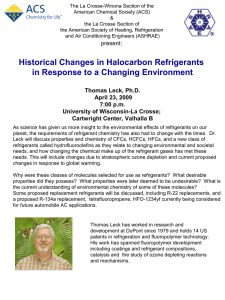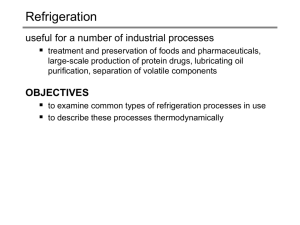Document 12908524
advertisement

International Journal of Engineering Trends and Technology (IJETT) – Volume2 Issue 2 Number1–Sep 2011 Performance Test On Refrigerator By Using Inorganic Refrigerants Mr. ASHOKKUMAAR.A Department of Mechanical Engineering, Bharath institute of science and technology, Bharath University, Chennai-600073,Tamilnadu ABSTRACT A vapour compression refrigeration system in which a suitable working substance termed as refrigerant is used .It condences and evaporates at temperature and pressure closed to atmospheric condition the refrigerant used for the purpose are ammonia, carbon dioxide and sulphur dioxide. Refrigerator consist five major parts-compressor, condenser, receiver, expansion valve, evaporator. The refrigerant used , does not leave the system but it circulated through the system alternately condensing and evaporating. In evaporation the refrigerant absorbs its latent heat from the brine(salt water) which is used for circulating it around the cold chamber , while condensing it give out its latent heat to the circulating water of the cooler. The vapour compression refrigeration system is a latent heat pump as it pump its latent heat from brine deliver to cooler. The vapour compression refrigeration system is now adays used for all purpose refrigeration. It is generally used for all industries purpose from a domestic refrigerator to abig air conditioning plant. In our project work, we have calculated the values of C.O.P of in organic refrigerants, those are carbon dioxide, sulphur dioxide and ammonia. After that we compare the values of C.O.P. Hence these systems are also called as mechanical refrigeration systems. Vapour Vapour compression refrigeration systems are the most commonly used among all refrigeration systems. As the name implies, these systems belong to the general class of vapour cycles, wherein the working fluid (refrigerant) undergoes phase change at least during one process. In a vapour compression refrigeration system, refrigeration is obtained as the refrigerant evaporates at low temperatures. The input to the system is in the form of mechanical energy required to run the compressor. ISSN: 2231-5381 compression refrigerationsystems are available to suit almost all applications with the refrigeration capacities ranging from few Watts to few megawatts. A wide variety of refrigerants can be used in these systems to suit different applications, capacities etc. The actual vapour compression cycle is based on Evans-Perkins cycle, which is also called as reverse Rankine cycle. Before the actual cycle is discussed and analysed, it is essential to find the upper limit of performance of vapour compression cycles. http://www.ijettjournal.org Page 13 International Journal of Engineering Trends and Technology (IJETT) – Volume2 Issue 2 Number1–Sep 2011 This limit is set by a completely reversible uncertain future. The most commonly used cycle. natural refrigerant is ammonia. This is also one of the oldest known refrigerants. The use of CFCs is now beginning to be phased out due to their damaging impact on the protective tropospheric ozone layer around the earth. The Montreal Protocol of 1987 and the subsequent Copenhagen agreement of 1992 mandate a reduction in the production of ozone depleting Chlorinated Fluorocarbon (CFC) refrigerants in a phased manner, with an eventual stop to all production by the year 1996. In response, the refrigeration industry has developed two alternative refrigerants; one based on Hydro-chloro Fluorocarbon Ammonia has good thermodynamic, thermophysical and environmental properties. However, it is toxic and is not compatible with some of the common materials of construction such as copper, which somewhat restricts its application. Other natural refrigerants that are being suggested are hydrocarbons (HCs) and carbon di-oxide (R-744). Though these refrigerants have some specific problems owing to their ecofriendliness, they are being studied widely and are likely to play a prominent role in future. (HCFC), and another based on Hydro Fluorocarbon (HFC). The HCFCs have a 2 to 10% ozone depleting Prior to the environmental issues of potential as ozone layer depletion and global warming, compared to CFCs and also, they have an the most widely used refrigerants were: R atmospheric lifetime between 2 to 25years as 11, R 12, and R 22. Of these, R 11 was compared to 100 or more years for CFCs primarily used with centrifugal compressors (Brandt, 1992). in air conditioning applications. R 12 was used primarily in small capacity refrigeration Synthetic refrigerants that were commonly used for refrigeration, cold storage and air conditioning applications are: R 717 (NH3), R 744 (CO2), R 764 (SO2), etc. However, these refrigerants have to be phased out due to their Ozone Depletion Potential (ODP). The synthetic replacements for the older refrigerants are: R-134a (HFC134a) and blends of HFCs. Generally, synthetic refrigerants are non-toxic and nonflammable. However, compared to the natural refrigerants the synthetic refrigerants offer lower performance and they also have higher Global Warming Potential (GWP). As a result, the synthetic refrigerants face an ISSN: 2231-5381 and cold storage applications, while the other refrigerants were used in large systems such as large air conditioning plants or cold storages. Among the refrigerants used, except ammonia, all the other refrigerants are synthetic refrigerants and are non-toxic and non-flammable. Though ammonia is toxic, it has been very widely used due to its excellent thermodynamic and thermo- physical properties. The scenario changed completely after the discovery of ozone layer depletion in 1974. Since ozone layer depletion could lead to catastrophe on a global level, it has been agreed by the global community to phase out the ozone depleting http://www.ijettjournal.org Page 14 International Journal of Engineering Trends and Technology (IJETT) – Volume2 Issue 2 Number1–Sep 2011 substances (ODS). As a result except search for suitable replacements began in ammonia, all the other refrigerants used in earnest. cold storages had to be phased-out and a Tabulation For Refrigerant SO2 Temp.of water Energy reading meter Pressure gauge T1 T2 watt T1 T2 T3 T4 30 20 200 14.4 14.4 -15 -15 55 12.1 4.57 200 13.5 13.5 -10 -10 70 25 200 10 10 -5 -4 80 200 5 4 -2 -2 98 Temperature(oc) C.O.P therotic al C.O.P actual Comp. work Actual Cooling effect KJ/Kg KJ/Kg 2.91 72 210 3.91 2.91 72 210 34 4.20 2.91 72 210 38 4.45 2.91 72 210 psi h1 = 203.67 KJ/kg , h2 = hf2 =43.82 KJ/ Calculation for refrigerant SO2 kg 1. Absolute pressure (P1) =Pressure h4 = 175 gauge × 0.07+1.013 KJ/ kg = (55× Theoretical C.O.P = h4 –hf2 / h1- h4 0.07 + 1.013 ) = 4.863 bar 2. = (175 – 43.82) / (203.67 – 175) Absolute pressure (P3) = (Pressure = 4.57 gauge × 0.07+1.013 ) =( 12.1× 4. 0.07 + 1.013 ) Actual cooling effect = mcp ( T1 – T2 ) =1.86 bar 3. =5 × 4.2 (30 At Temperature -20) T1 = T2 = 14.45 oC = 210 KJ/Kg 5. T3 = T4 = - 15 o Actual compressor work = 3600 × 0.02 C = 72 From refrigeration chart ISSN: 2231-5381 KJ/kg http://www.ijettjournal.org Page 15 International Journal of Engineering Trends and Technology (IJETT) – Volume2 Issue 2 Number1–Sep 2011 6. Actual C.O.P = ( Actual cooling = ( 210/72 ) effect / actual compressor work ) = 2.91 Tabulation For Refrigerant CO2 Temp.of water Energy reading meter Temperature(oc) Pressure gauge C.O.P therotic al T1 T2 watt T1 T2 T3 T4 30 20 200 25 25 -5 -5 61 15.5 3.57 200 20 21 -4 -3 70 20 200 15 16 -1 -2 80 200 10 11 0 0 115 C.O.P actual Comp. work Actual Cooling effectr KJ/Kg KJ/Kg 1.94 108 210 2.91 1.94 108 210 35 3.06 1.94 108 210 70 3.58 1.94 108 210 psi h4 = 221.83 KJ/ kg Calculation for refrigerant CO2 1. Absolute pressure (P1) =Pressure Theoretical C.O.P = h4 –hf2 / h1- h4 gauge × 0.07+1.013 = (221.83 – = (61× 164.77) / (237.83 – 221.83) 0.07 + 1.013 ) = 3.57 = 5.29 bar 2. Absolute pressure (P3) = (Pressure gauge × 0.07+1.013 ) =( 15.5× 4. Actual cooling effect = mcp ( T1 – T2 ) 0.07 + 1.013 ) =5 × 4.2 (30 =2.09bar 3. -20) At Temperature = 210 KJ/Kg T1 = T2 = 25 o 5. C Actual compressor work = 3600 × 0.03 T3 = T4 = - 5 o = 108 C KJ/kg From refrigeration chart h1 = 237.83 KJ/kg , h2 = hf2 =164.77 6. effect / actual compressor work ) KJ/ kg ISSN: 2231-5381 Actual C.O.P = ( Actual cooling http://www.ijettjournal.org Page 16 International Journal of Engineering Trends and Technology (IJETT) – Volume2 Issue 2 Number1–Sep 2011 = ( 210/108 ) = 1.94 Tabulation For Refrigerant NH3 Temp.of water Energy reading meter Temperature(oc) Pressure gauge C.O.P Therotical T1 T2 watt T1 T2 T3 T4 25 20 200 30 30 -5 -5 65 20 1.68 200 25 24 -3 -3 70 25 200 20 19 -2 -2 80 200 15 15 0 0 90 C.O.P actual Comp. work Actual Cooling effectr KJ/Kg KJ/Kg 1.45 72 105 1.62 1.45 72 105 35 1.65 1.45 72 105 40 1.57 1.45 72 105 psi Calculation for refrigerant NH3 h1 = 270.56 KJ/kg , h2 = hf2 =170.76 1. Absolute pressure (P1) =Pressure KJ/ kg gauge × 0.07+1.013 h4 = = (65× 230.87 KJ/ kg 0.07 + 1.013 ) = 5.563 Theoretical C.O.P = h4 –hf2 / h1- h4 bar 2. Absolute pressure (P3) = (Pressure gauge × 0.07+1.013 ) = (230.87 – 170.76) / (270.56 – 230.87) =( 20× = 1.68 0.07 + 1.013 ) =2.413bar 3. 4 At Temperature Actual cooling effect = mcp ( T1 – T2 ) T1 = T2 = 30 =5 × 4.2 (25 o C -20) T3 = T4 = - 5 = 105 o C KJ/Kg From refrigeration chart 5 . Actual compressor work = 3600 × 0.02 ISSN: 2231-5381 http://www.ijettjournal.org Page 17 International Journal of Engineering Trends and Technology (IJETT) – Volume2 Issue 2 Number1–Sep 2011 = 72 KJ/kg References: 6 .Actual C.O.P = ( Actual cooling effect / actual compressor work ) 1. = ( 105/72 ) A text book of Refrigeration and Air conditioning by R.S KHURMI and J.K GUPTA, S.CHAND = 1.45 publication, 2009. CONCLUSION 1. 2. conditioning by S.C ARORA and For refrigerant SO2 (R-764) S.DOMKUNDWAR publication, 1997. Theoretical C.O.P = 4.57 Actual C.O.P =2.91 2. 3. Applied thermodynamics by P.K NAG, TMH publication,2008. 4. For refrigerant CO2 (R-744) Mechanical refrigeration by SPARK and DILLO,TMH publication,2005. Theoretical C.O.P = 3.57 Actual 5. C.O.P =1.94 3. A course in Refrigeration and Air- Refrigeration notes by I.I.T KHARAGHPUR. For refrigerant NH3 (R-717) Theoretical C.O.P = 1.68 Actual C.O.P =1.45 As for testing of C.O.P we realised that the C.O.P of NH3 are much lower than another two inorganic refrigerant. So, that’s wise NH3 has more cooling efficiency . Hence it is most common and widely used in large and commercial reciprocating compression system where toxicity is secondary. ISSN: 2231-5381 http://www.ijettjournal.org Page 18




